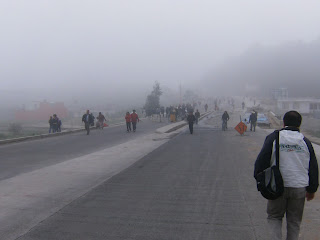Today I decided to spend the morning at the hospital's public clinic, observing an internist in the women's open clinic. When I arrive at 7:45 or 8am, there is already a crowd of people lined up outside the receptionist office, and they don't start seeing patients until usually 8:30 or 9am. I don't know what time they start lining up outside, but it's certainly much earlier. Most of the patients seen here are indigenous and many don't speak Spanish, so they often come with several family members to help interpret. After they're signed in, a group of women are given thermometers to put under they're tongues and one by one they're temperatures are noted down before they go in to see the doctor.
Dr. Joanna Rogosh is the internist who sees patients on weekday mornings. She is from Poland and came to Xela during her travels more than a decade ago to go to Spanish school. She liked it so much that she decided to stay for a while. She had always been interested in medicine as a profession, so she decided to go to medical school here. She was in medical school for the full 6 years and in the meantime met a Guatemalan man and got married. She now has a 4 year old son, but has divorced her husband since, and has been practicing medicine for 4 years. Her father now lives in Germany and she has been talking about moving there soon with her son. From what I've observed of Dr. Rogosh with her patients, I'd say that she's an outstanding doctor by any standard. She listens intently to the gripes of the patients while also keeping them focused on one thing at a time. Patients will often just come in and list off all their aches and pains and the doctor has to stop them and ask about the nature and history of each complaint.
It's sometimes a whole other ballgame when seeing patients who only speak their indigenous language and almost no Spanish. One woman came in complaining that she had not had "
orina grande (big urine)" in a few days and she is only able to go every few days. The doctor asked if she had urinated yet today. The patient said that she had "
orina pequeña (small urine)" this morning, but has not had "
orina grande" since a couple days ago. After many questions and much confusion, the doctor realized that when the patient said
orina grande, she was actually referring to poop, and
orina pequeña referred to pee. Whew, ok, so now we know the patient's constipated! Apparently in a prior lab test they also found that she had tested positive for
Helicobacter pylori, which causes gastris and stomach ulcers.
In general, Guatemala's public health system is pretty good, considering that you can see a doctor and be admitted to the hospital at no personal cost. After admission, however, there are many things that the patient will have to pay for out of pocket. Usually the more routine diagnostic tests, such as routine hematology, xrays, echocardiograms, etc. are done free at the hospital, but if patients needs a CT scan, a MRI, or if the hospital's blood analysis machines happen to not be working that day, they must go to a private clinic where they have those resources. And at the private clinics you pay out of pocket. Then you can take the results back to hospital and continue your treatment there. Most medicines must also be paid for by patients, and when it may be an expensive antibiotic that they need, they often go without.
The last patient Dr. Rogosh saw before I left for the day was an older woman, maybe around 60 years old, that was going through chemotherapy for cervical cancer, which had spread to her bladder. Poor woman. Dr. Rogosh had obviously seen her many times before and was closely following her case. Today she complained of fever, nausea, and vomiting. She had a catheter coming out of her side, directly from the kidney, because she could no longer urinate normally. The bag that took the urine had a hole in it and the smell of stale, infected urine filled the exam room in seconds. They got her a new bag. Dr. Rogosh informed the woman and her family that she would admit her into the hospital right away to treat the infection, but that they don't have a strong enough antibiotic to treat her with and that she would have to go to the public hospital in Xela instead. The woman said that she had been there before for her infected catheter, but that she was not attended well. She said that just a couple of med students looked at it and sent her home, only to then return to this hospital a couple days later. Dr. Rogosh said that she would send a note with the woman to the hospital in Xela explaining the problem, but then on second thought she decided not to because then they may refuse to treat her because she had already been seen at this one. It sounds so insensitive, but the doctor said that is the way many public hospitals work. So Dr. Rogosh told the woman to go to the emergency room and from there the Xela hospital would have to admit and treat her. We could only hope that after the hour and a half bus ride to Xela the woman would indeed be admitted and not turned away once again for whatever reason.




















































